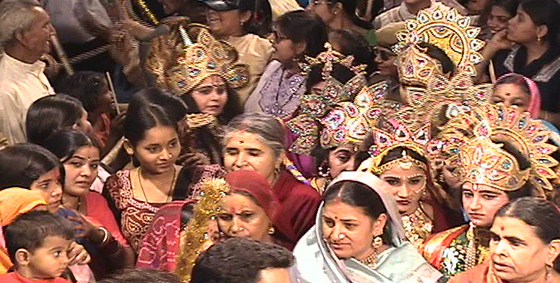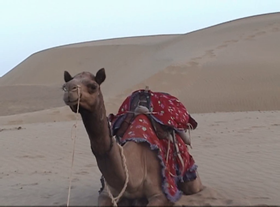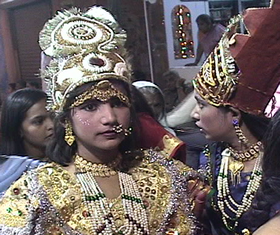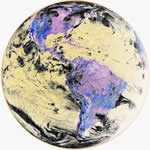Betmaar: Women's Man-Beating Festival
~Exclusive Documentary Promo at the end of the article~
By Brook & Gaurav Bhagat

JODHPUR, INDIA-- Dreams of exotic adventure-- turbaned maharajas, desert princesses and camel safaris-- have made Rajasthan the most touristed state in all of India. While reality is never quite like the storybooks, the twists and turns of a real-life tour of Rajasthan are sure to make a much deeper impression than any fantasy can do.
Located in the Thar desert, Rajasthan is famous for its rich, spicy food and culture, its warm hospitality, and (of course) its camels; all these things are real. India’s warmth is more than skin-deep; at the end of almost every conversation or meeting, no matter how casual, the last words will be, "Come to my home." And when you go to a Rajasthani home for dinner, remember to start saying "bas"- no more- when you are only half full, because you will be fed more, more, and then a few sweets more to show what a welcome and honored guest you are.

Camels, like hospitality, are a part of everyday life in Rajasthan; you need not go further than any main road to see them, pulling everything from giant stone slabs to small boys on wooden carts. If you want a more intimate experience, however, you can take a camel-back safari over the sand dunes.
Camel safaris are available in popular tourist towns like Pushkar and Jaisalmer, for everything from a half-hour ride over the sand dunes to fortnight-long treks across the desert. My husband and I, having heard rumors about the strenuous nature of riding these “ships of the desert,” opted for an hour-long excursion.
We caught our ride in Jaisalmer, in the heat of early evening; it seemed surreal, the dunes spreading endlessly to the West, haggling in Hindi for the right price with a boy who could have walked out of a thousand-year-old painting-- until he told us our camel’s name was Michael Jackson.
It was a bumpy ride on a colorful saddle that seated two, complete with camel burps and a view of the dung beetles crawling over the dunes. The tassels fluttered in the hot desert wind, and the storybook feeling returned; then children appeared, as if out of thin air, carrying steel buckets of ice and high-priced soft drinks to sell to tourists.
We stopped at “sunset point” halfway through the ride. We had made it just in time for the title event; Michael Jackson kneeled down, front legs first, and we climbed down to join the others on the sand.
Two dozen or so locals had silently gathered for the spectacular sunset. The sun was blazing, bleeding reds and yellows across the sky. Then, while his father played the ravan-haththa, a stringed Rajasthani folk instrument known for its heartbreaking strains, a boy not more than three or four years old sang a song, ripe with yearning, regret and triumph. Emotions flowed into each other, spilling out from the child like water... whatever it was, I thought later, how could he know so soon?
Another popular tourist destination is Jodhpur, featuring the famous Mehrangarh fort, Jaswanthada, and Umaid Bhavan palace, home of a former Maharaja, a five star deluxe hotel and a museum. Also of interest: Kailana lake and the nearby cave temple, Mandore garden featuring monuments and temples of historical significance, the clock tower and many other temples, most of which can be enjoyed without cost.
For food, get ready for Jodhpur's famous, spicy "Mirchibada," a green chili battered and fried. Generally one can get good food for approximately $1-2. There is a wide range of choices when it comes to street food (pakoras, pani-patasha, ice cream etc.). Gourmet a/c restaurants, serving Indian, Chinese and occasionally Continental food, are also available.

The wildest and most unique Indian festival I have experienced, celebrated only in Jodhpur, is called "Betmaar," which means beating with a stick. At Betmaar, women parade through the streets in packs, singing, yelling and carrying sticks, which they use to beat any man who comes in their way.
On this night, no man dares deny a woman what she demands, be it ice cream, sweets, etc. Many women dress in drag, with costumes and makeup ranging from classical maharajas to Bollywood film stars.
Men also roam the narrow inner city streets in groups, teasing the women until the sticks come down, and then running, howling with laughter (and sometimes real pain).
I was hesitant at first to join in, but soon discovered that a whack with a small stick (which I later exchanged for a bigger one) made a much better reply to leering glances than my broken Hindi; we met with friends, who pulled me safely into the middle of a group of ten or fifteen women and girls. We roamed the streets until 3 or 4 in the morning, dancing, eating sweets, and joyfully beating men.
While Betmaar’s general tone is playful, the festival is not without deeper meaning: it is an annual reminder of the real power of the goddess, which all women carry within them.
This power must be honored, or offenders will feel her wrath. For me too, it was a reminder of my power as a woman, a chance to honor the “goddess” within and claim that power.
Extravagant statues of the goddess, many with real gold and jeweled ornaments, were assembled in at least a dozen places in the city; we offered silent prayers to each one. These small shrines were overflowing with flowers, sweets and bhang-prasad (a blessed food made with marijuana leaves), which was given to everyone who wanted it.
Along the way, we got to see teenagers perform a lip-synced drag show on stage, hilariously capturing the dance moves of the latest Hindi pop music hunks.
A few hours later, far away from the loudspeakers, we got a glimpse of the son of the real maharaja of Jodhpur. The crowd was silent as, flanked by bodyguards and officials, he and his wife stepped from a clean white car to pay their respects to the goddess.
The festival ended when the parade reached the goddess’s temple, where pooja, a short prayer ceremony, was performed. I closed my eyes and received a smudge of sindoor on my third eye.
The most important things to remember about Betmaar are to wear good walking shoes, keep your wits about you (beware of bhang-prasad) and decide on a place to meet in case your party gets separated. The crowds can get wild, which should also be a consideration for elderly tourists or those with small children. So bring your water bottle, your courage, and if you are a woman, your stick, and enjoy!
India is not for the faint of heart; but for travelers with an open spirit, something intangible will reach you here-- something in the air, in the very earth beneath your feet-- that is very real, and that you will not find anyplace else in the world. There are no words for what it is, but its echo will stay with you, calling you back to “Mother India” again and again... and you will come.
The following film is an exclusive, unaired, first-edit feature-length documentary's promo about Betmaar.
Want to rent/buy instead and watch full documentary?
Betmaar: Queens of the Night
Copyright 2004-2015, Third Eye Creations
Did you like the article? Subscribe here to our New Article Email Alert or RSS feeds.
Sharing is caring! Don't forget to share the love, and keep the conversation going by leaving a comment below:
Advertisement
